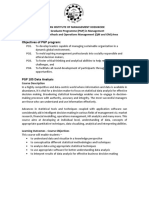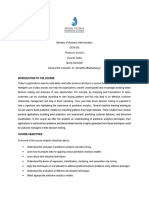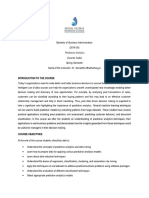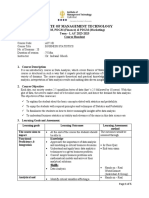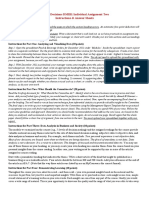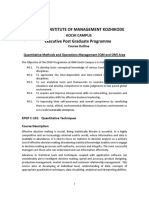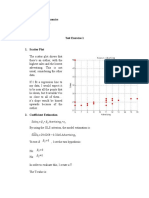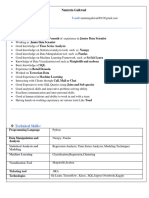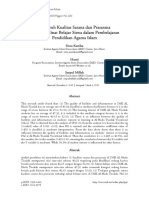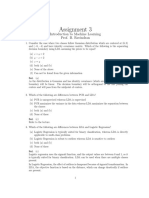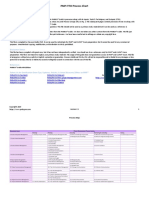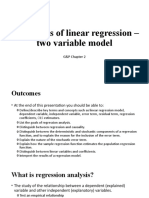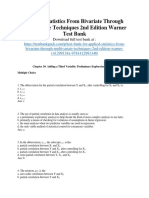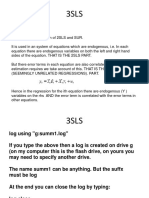Course title : Fundamentals of Data Analysis (FDA)
Batch : PGDM 2020-22
Term :1
Credits :2
Faculty : Dr. Srilakshminarayana G
Email ID : lakshminarayana@sdmimd.ac.in Mobile : +91-9538469424
About the Course:
With increase in the use of technology and processes for retrieval and storage of the data,
it has become a mandatory practice to take decisions based on the results of the data
analysis. Such decisions add value to the business and gives an upper edge over the
competitors. Taking this into consideration, decision makers look for right data and right
statistical method for analysing the data. The challenge is in identifying the right method
for the given situation, applying all the steps systematically and communicating the results
effectively. To achieve this, one needs to undergo training formally and the current course
is designed to meet this requirement.
Introduction:
The course is divided into three parts. The first part focuses on exploratory data analysis,
under which the students will be trained on visualizing the data, summarizing the data and
presentation of the results for decision making. The second part focuses on probability and
its use in decision making under uncertainty. The third part focuses on statistical estimation
of the key parameters of the given situation. Under the first part, the student will be taught
on data visualization, describing the key variables using summary statistics, finding the
outliers in the data set etc. Under the second part, the student will be taught on fundamentals
of probability, calculation of probabilities related to normal and rare events, and, important
probability models. Under the third part, they will be taught the process of integrating the
methods for analysing the data and use the results effectively to take appropriate decisions.
The entire course will be data driven and the data sets will be shared with the students from
time to time.
Page 1 of 7
�Course Learning Objectives (CLO):
CLO1: To develop skills to present the summary of the data using appropriate methods
and extract the latent information in a unique way that creates value to the organization
CLO2: To develop skills to apply the methods used to handle the uncertainty in business
and approach the problems uniquely by involving organizations to create value
CLO3: To learn to develop probability models to handle uncertainty and estimate the
chances of occurrence of normal and rare events in business
CLO4: To learn the process of integrating various methods and provide solutions to the
business problems that creates value to the organizations by involving everyone in the
given situation
Course Objectives linked to the Mission statement of SDMIMD:
Business Leadership:
The course identifies the leader as the one who identifies a situation where there is a need
for the data, recognizes the source and collects the data systematically, selects appropriate
method to analyze the data, applies the same with perfection, and communicates the results
to others in an efficient and effective way. Based on the level of approach (as mentioned
under rubrics), the students will be evaluated. Also, a leader will be the first one to respond
appropriately in a given situation and gives solutions to the issues identified. The course
treats a student as a leader if he/she will be the first one to react to a given situation and
leaves not any of the issues identified.
Organizational Excellence:
The information extracted through the data analysis has to be associated with the
organizational goals and help the organizations in taking appropriate decisions to reach the
goals. The course treats a student with organizational excellence, if he/she links back the
results of the analysis to the organizational needs. Also, he/she should apply the steps in a
right way and present the same in right way. It is also necessary for the student to link the
results one-to-one, based on the situation under consideration.
Page 2 of 7
�Value Creation:
The course creates a value by training the student in making the data ready for the analysis,
selecting appropriate method, and observe the latent information that is present in the data.
Optimum usage of the data is a key to achieve this objective. A student himself becomes a
value addition if he/she is aware of the methods and use them appropriately when
necessary. Also, links the solutions with others disciplines of management, relevant to the
organization. The conclusions drawn/solutions provided adds value to the
organization/people/department etc., associated with the given situation and make them to
implement the same.
Pedagogy:
The course mainly focuses on application of statistical methods decision making via data
analysis. Hence, the sessions will be a blend of presentation of concepts as well as
application of the same for analysing the data. Data sets, considered from marketing,
finance, HR etc., will be sent to the students for preparation and process of analysing the
same will be discussed during the sessions.
Course Evaluation: (No component should exceed 30% of the total)
Component % marks
Class Participation 10%
Quiz-1 25%
Quiz-2 25%
Mid Term Exam 20%
Final Exam 20%
Total 100
Assessment Methods Linked to Specific Course Objectives
Mission Attributes Class Participation Quiz Written Exams
Business Leadership Yes - Yes
Organizational Excellence - - Yes
Value Creation Yes - Yes
Page 3 of 7
�Session Plan
Session Topics
Introduction to the course, its importance in business, types of data, types of studies,
1-2
scaling etc.
3-5 Data Visualization: Tabular and Graphical.
Descriptive Data Analysis: Numerical Measures-Measures of Central Tendency,
6-9
Dispersion, and Shape.
10-12 Introduction to Probability and its applications in decision making.
13-14 Bayes’ theorem and its applications in decision making.
15-17 Random variables and applications in decision making.
Normal Distribution and its applications in decision making. Central limit theorem
18-20
and its applications.
CLO-PEO Matrix
PEO 1 PEO 2 PEO 3 PEO 4 PEO 5
CLO 1 LOW HIGH HIGH LOW MEDIUM
CLO 2 LOW HIGH HIGH LOW LOW
CLO 3 LOW MEDIUM HIGH LOW LOW
CLO 4 LOW HIGH HIGH LOW MEDIUM
Overall intended outcome
LOW HIGH HIGH LOW MEDIUM
of the course
Page 4 of 7
� Rubrics:
1. Rubric for Class Participation
Quality Exceptional Excellent Average Needs major
improvement
Objectives
Student who understands Student who understands Student who understands Student who never
the situation clearly the situation in most of the the situation sometimes makes an attempt to
always and indicates the times and indicates the and indicates the need understand the
need for the data, need for the data, for the data, discusses situation and never
discusses the advantages discusses the advantages the advantages of using participates in the
of using the data and of using the data and the data and presents the discussions.
presents the right method presents the right method right method for
for analysing the data. for analysing the data. analysing the data.
Participates actively Participates actively Participates sometimes
Business Leadership
during the online during the online during the online
discussions. discussions. discussions.
Student who reacts on Student who reacts on the Student who sometimes Student who never
the chat box first for the chat box and presents the reacts on the chat box reacts to the
questions asked and view points during the and present the view questions asked and
presents his/her view discussions by linking points by linking them never participates in
online during the them to the organizational sometimes to the the discussions.
discussions uniquely by needs organizational needs
linking them to the during the online
organizational needs discussions.
Student who comes Student who comes Comes prepared to the Never comes to the
prepared always to the prepared to the class most class sometimes. class prepared.
class. of the times.
Student who gives Student who gives Student who gives Student who gives
Value Creation
viewpoints always that viewpoints in most of the viewpoints sometimes never gives
create value to the times that create value to that create value to the viewpoints that
organizational needs the organizational needs organizational needs create value to the
organizational
needs
Page 5 of 7
� Participates actively Participates in most of the Participate sometimes Never participates
during the online times during the online during the online during the online
discussions and adds discussions and adds value discussions and adds discussions and
value to the class to the class learning. value to the class adds never makes
learning always. learning. an attempt to add
value to the class
learning.
2. Rubric for written exams
Quality Exceptional Excellent Average Needs major
improvement
Objectives
Answers all the questions Answers most of the Answers some of the Answers few of the
by adopting the required questions and presents the questions properly and questions and do
Business Leadership
steps. Also, presents the answers in an elegant way. presents the answers in a not present the same
answers with elegant The steps required are reasonable way. Does properly. Gives
handwriting. The followed almost surely not focus much steps but only the final
interpretation for the and uses tools gives only the answers. numerical answer
results is outstanding and appropriately. Fails to without any
leads to better decision answer few questions managerial
making. properly. interpretation.
Links the answers always Links in most of the cases Links in some of the Links occasionally
Organizational Excellence
to the organizational to the organizational cases to the the cases to the
issues and provides issues and provides organizational issues and organizational
solutions to all the issues. solutions. provides solutions. issues and provides
solutions.
Page 6 of 7
�Value Creation Provides the answers Provides the answers in Provides the answers in Provides the
which can be used in most of the cases which some of the cases which answers in few of
taking decisions, always. can be used in taking can be used in taking the cases which can
decisions. decisions. be used in taking
decisions.
Recommended Textbook:
Anderson, D. R., Sweeney, D.J., Williams, T. A., Camm, J., D., and Cochran, J. J., (2017):
Statistics for Business and Economics.12th Edition. Cengage.
References:
1. Levine, D. M., Berenson, M.L., Krehbiel, T. C., and Stephan, D. F. (2011): Statistics
for Managers using MS Excel. 6th edition. Pearson.
2. Levin, R. I., and Rubin, D. S. (2000): Statistics for Management. 7th Edition. Pearson.
3. Keller, G. (2012): Managerial Statistics. 9th Edition. South-Western Cengage.
4. Aczel, A.D., Sounderpandian, J., Saravanan, P., and Rohit, J. (2009): Complete
Business Statistics. 7th Edition. Tata McGraw Hill.
5. Stine, R. and Foster, D. (2011): Statistics for Business: Decision making and analysis.
Pearson.
6. Ken Black (2016): Applied Business Statistics: Making Better Business Decisions.
International Student version. Wiley.
Page 7 of 7










